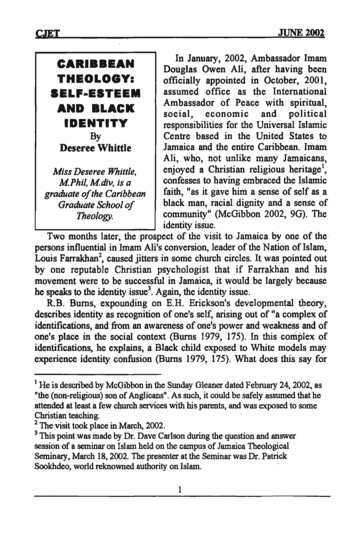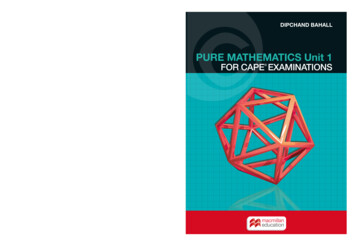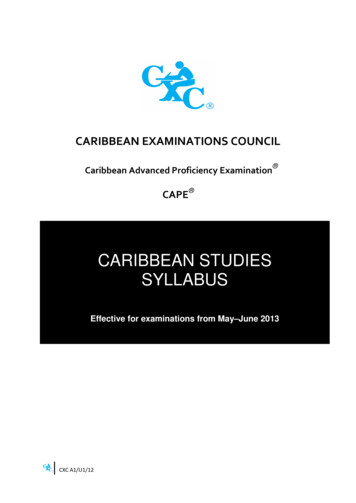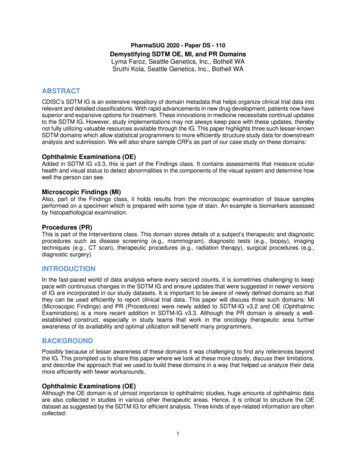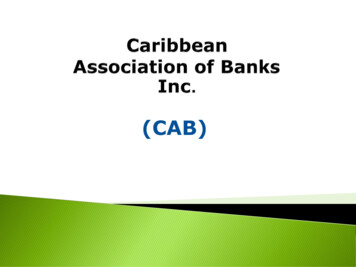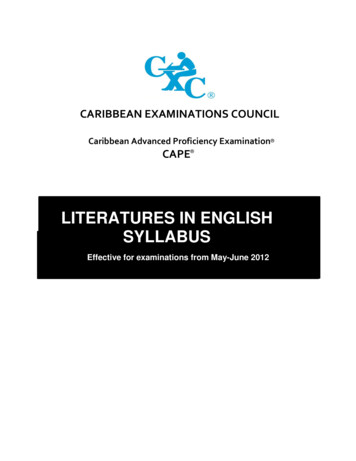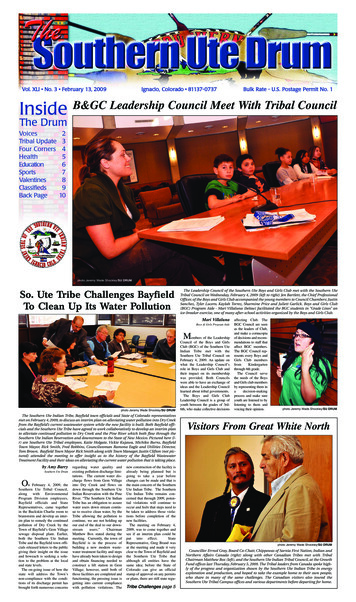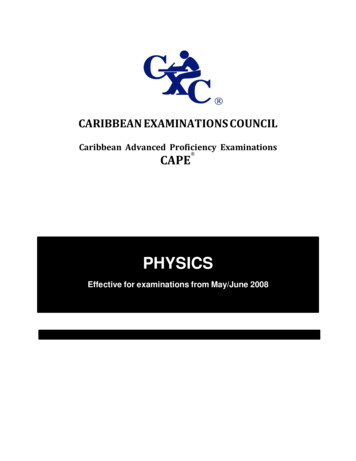
Transcription
CARIBBEAN EXAMINATIONS COUNCILCaribbean Advanced Proficiency Examinations CAPEPHYSICSEffective for examinations from May/June 2008CXC A16/U2/07
Published by the Caribbean ExaminationsAll rights reserved. No part of this publication may be reproduced, stored in a retrieval system, ortransmitted in any form, or by any means electronic, photocopying, recording or otherwise without priorpermission of the author or publisher.Correspondence related to the syllabus should be addressed to:The Pro-RegistrarCaribbean Examinations CouncilCaenwood Centre37 Arnold Road, Kingston 5, Jamaica, W.I.Telephone: (876) 630-5200Facsimile Number: (876) 967-4972E-mail address: cxcwzo@cxc.orgWebsite: www.cxc.orgCopyright 2007 by Caribbean Examinations CouncilThe Garrison, St Michael BB14038, BarbadosCXC A16/U2/07ii
ContentsRATIONALE. 1AIMS . 1SKILLS AND ABILITIES TO BE ASSESSED . 2PRE-REQUISITES OF THE SYLLABUS . 5STRUCTURE OF THE SYLLABUS . 5UNIT 1: MECHANICS, WAVES AND PROPERTIES OF MATTERMODULE 1: MECHANICS . 6MODULE 2: OSCILLATIONS AND WAVES . 18MODULE 3: THERMAL AND MECHANICAL PROPERTIES OF MATTER . 27UNIT 2: ELECTRICITY AND MAGNETISM, A. C. THEORY AND ELECTRONICS ANDATOMIC AND NUCLEAR PHYSICSMODULE 1: ELECTRICITY AND MAGNETISM . 37MODULE 2: A. C. THEORY AND ELECTRONICS . 47MODULE 3: ATOMIC AND NUCLEAR PHYSICS. 56OUTLINE OF ASSESSMENT . 64REGULATIONS FOR PRIVATE CANDIDATES . 68REGULATIONS FOR RESIT CANDIDATES. 69ASSESSMENT GRID . 69RESOURCES . 70GLOSSARY . 71LIST OF MINIMUM LABORATORY REQUIREMENTS . 76LIST OF PHYSICAL CONSTANTS . 78MATHEMATICAL REQUIREMENTS . 80SUMMARY OF KEY QUANTITIES, SYMBOLS AND UNITS. 83CXC A16/U2/07
This document CXC A16/U2/07 replaces CXC A16/U2/01 issued in 2001.Please note that the syllabus was revised and amendments are indicated by italics.First issued 1999Revised 2001Revised 2007Please check the website, www.cxc.org for updates on CXC’s syllabuses.CXC A16/U2/07ii
TIntroductionThe Caribbean Advanced Proficiency Examination (CAPE) is designed to provide certification of theacademic, vocational and technical achievement of students in the Caribbean who, having completeda minimum of five years of secondary education, wish to further their studies. The examinations addressthe skills and knowledge acquired by students under a flexible and articulated system where subjects areorganised in 1-Unit or 2-Unit courses with each Unit containing three Modules. Subjects examined underCAPE may be studied concurrently or singly.The Caribbean Examinations Council offers three types of certification. The first is the award of a certificateshowing each CAPE Unit completed. The second is the CAPE diploma, awarded to candidates who have satisfactorilycompleted at least six Units, including Caribbean Studies. The third is the CAPE Associate Degree, awarded forthe satisfactory completion of a prescribed cluster of seven CAPE Units including Caribbean Studies andCommunication Studies. For the CAPE diploma and the CAPE Associate Degree, candidates must complete thecluster of required Units within a maximum period of five years.Recognised educational institutions presenting candidates for CAPE Associate Degree in one of the nine categoriesmust, on registering these candidates at the start of the qualifying year, have them confirm in the required form, theAssociate Degree they wish to be awarded. Candidates will not be awarded any possible alternatives for which theydid not apply.CXC A16/U2/07
TPhysics Syllabus RATIONALEScience plays a major role in the evolution of knowledge. It empowers us to use creative and independentapproaches to problem solving. It arouses our natural curiosity and enables us to meet diverse and everexpanding challenges. It enhances our ability to inquire, seek answers, research and interpret data. These skillslead to the construction of theories and laws that help us to explain natural phenomena and exercise control overour environment. Science is, thus, an integral component of a balanced education.The most important natural resource in the Caribbean is its people. If the Caribbean is to play an important role inthe new global village and survive economically, a sustained development of the scientific and technological resourcesof its people is essential.Physics is generally regarded as the most fundamental scientific discipline. The study of Physics is necessary toexplain our physical environment. In fact, this is the role of the laws and theories of Physics that influenceevery aspect of our physical existence. In particular, whatever conveniences and luxuries we enjoy as citizens ofCaribbean nations can either directly or indirectly be traced to these fundamental physical laws and theories.This CAPE syllabus in Physics is, therefore, designed to provide a coherent course of study which addresses, inaddition to a specific knowledge base, the development of related skills and attitudes. The syllabus takes intoaccount the requirements for tertiary education at regional and international institutions. It is also structured insuch a way as to ensure that students become aware of their moral, social, and ethical responsibilities, as well as thebenefits intrinsic to the practical application of scientific knowledge to careers in the scientific field. AIMSThe syllabus aims to enable students to:1.acquire understanding and knowledge of technological and scientific applications of Physics, especiallyin the Caribbean context;2.demonstrate an awareness and understanding of natural phenomena which affect this region and theirsensitivity to concerns about the preservation of our environment;3.develop an understanding of the scientific process and their recognition of its usefulness and itslimitations;CXC A16/U2/071
4.encourage the development of rational and ethical attitudes and behaviours in the application ofPhysics;5.develop critical thinking, analytical and inquiry skills;6.provide appropriate scientific training for the purposes of employment, further studies and personalenhancement;7.stimulate an interest in and love for the study of Physics. SKILLS AND ABILITIES TO BE ASSESSEDThe skills students are expected to develop on completion of this syllabus have been grouped under three mainheadings:(i)(ii)(iii)Knowledge and Comprehension;Use of Knowledge; andExperimental Skills.Knowledge and Comprehension (KC)KnowledgeThe ability to identify, remember, and grasp the meaning of basicfacts, concepts and principles.ComprehensionThe ability to select appropriate ideas, match, compare and citeexamples of facts, concepts and principles in familiar situations.Use of Knowledge (UK)ApplicationCXC A16/U2/07The ability to:-use facts and apply concepts, principles and procedures infamiliar and novel situations;-transform data accurately and appropriately;-use formulae accurately for computational purposes.2
Analysis and InterpretationSynthesisEvaluationThe ability to:-identify and recognise the component parts of a whole andinterpret the relationship among those parts;-identify causal factors and show how they interact with eachother;-infer, predict and draw conclusions;-make necessary and accurate calculations and recognise thelimitations and assumptions of data.The ability to:-combine component parts to form a new and meaningfulwhole;-make predictions and solve problems.The ability to:-make reasoned judgements and recommendations based on thevalue of ideas, information and their implications;-analyse and evaluate information from a range of sources togive concise and coherent explanations of scientificphenomena;-assess the validity of scientific statements, experiments, results,conclusions and inferences.Experimental Skills – (XS)Observation, Recording and ReportingCXC A16/U2/07The ability to:-select observations relevant to the particular activity;-make accurate observations and minimise experimental errors;-report and recheck unexpected results;-select and use appropriate models of recording data orobservations, for example, graphs, tables, diagrams;3
Experimental Skills – (XS) (cont’d)Manipulation and MeasurementPlanning and DesigningCXC A16/U2/07-record observations, measurements, methods and techniqueswith due regard for precision, accuracy, and units;-present data in an appropriate manner, using the acceptedconvention of recording errors and uncertainties;-organise and present information, ideas, descriptions andarguments clearly and logically in a complete report, usingspelling, punctuation and grammar with an acceptable degreeof accuracy;-report accurately and concisely using scientific terminology andconventions as necessary.The ability to:-follow a detailed set or sequence of instructions;-use techniques, apparatus and materials safely and effectively;-make observations and measurements with due regard forprecision and accuracy.The ability to:-make predictions, develop hypotheses and devise means ofcarrying out investigations to test them;-plan experimental procedures and operations in a logicalsequence within time allocated;-use experimental controls where appropriate;-modify an original plan or sequence of operations as a result ofdifficulties encountered in carrying out experiments orobtaining unexpected results;-take into account possible sources of errors and danger in thedesign of an experiment;-select and use appropriate equipment and techniques.4
PRE-REQUISITES OF THE SYLLABUSAny person with a good grasp of the Caribbean Secondary Education Certificate (CSEC) Physics syllabus, or itsequivalent, should be able to pursue the course of study defined by this syllabus. However, successfulparticipation in the course of study will also depend on the possession of good verbal and writtencommunication and mathematical skills (see page 78 for mathematical requirements). STRUCTURE OF THE SYLLABUSThis syllabus is arranged into TWO Units, each made up of three Modules. Whilst each Module in each Unit is independent,together they form a coherent course of study which should prepare candidates for the world of work and studies at the tertiarylevel.Unit 1:Mechanics, Waves, Properties of MatterUnit 1 is expected to be covered in approximately 150 hours, and consists of three Modules. This Unit is structured as follows:Module 1Module 2Module 3Unit 2:-MechanicsOscillations and WavesThermal and Mechanical Properties of MatterEl e c t r i c i t y a n d M a g n e t i s m , A . C . Th e o r y a n d El e c t r o n i c s and Atomic and Nuclear PhysicsUnit 2 is expected to be covered in approximately 150 hours, and consists of three Modules. This Unit is structured asfollows:Module 1Module 2Module 3-Electricity and MagnetismA. C. Theory and ElectronicsAtomic and Nuclear PhysicsThe syllabus is arranged into two (2) Units, Unit 1 which will lay the foundation, and Unit 2 which expands on and appliesthe concepts formulated in Unit 1. It is, therefore, recommended that Unit 2 be taken after satisfactory completion of Unit1 or a similar course. Each Unit will be certified separately.For each Module there are general and specific objectives. The general and specific objectives indicate the scope of thecontent, including practical work, on which the examination will be based. However, unfamiliar situations may be presentedas stimulus material in a question.Explanatory notes are provided to the right of some specific objectives. These notes provide further guidance to teachers as tothe level of detail required.Th e s i n g l e u n d e r l i n i n g o f a s p e c i f i c o b j e c t i v e and its explanatory notes, indicate those areas of the syllabus that aresuitable for practical work. However, practical work should not necessarily be limited to these objectives.It is recommended that of the approximately 50 hours suggested for each Module, a minimum of about 20 hours be spent onlaboratory-related activities, such as conducting experiments, making field trips and viewing audio-visual materials.CXC A16/U2/075
UNIT 1: MECHANICS, WAVES, PROPERTIES OF MATTERMODULE 1: MECHANICSGENERAL OBJECTIVESOn completion of this Module, students should:1.understand physical quantities;2.apply the SI system of units and standard conventions;3.solve problems of bodies at rest, in uniform motion, or uniformly accelerated motion under theinfluence of forces in one and two dimensions;4.appreciate the effects of forces acting on a body;5.understand the principle of conservation of energy;6.design and carry out experiments to test relationships between physical quantities;7.appreciate that the measurement of a physical quantity is subject to uncertainty.SPECIFIC OBJECTIVES1.EXPLANATORY NOTESPhysical QuantitiesStudents should be able to:1.1express physical quantities as a numericalmagnitude and unit;1.2distinguish between scalar andquantities, and state examples;1.3combine and resolve vectors;1.4measure physical quantities using appropriateinstruments;1.5construct and use calibration curves;CXC A16/U2/07Some quantities are dimensionless, for example,refractive index, relative density.vectorBoth graphically and by calculation.Add and subtract vectors using components.Non-linear curves may be included.6
UNIT 1MODULE 1: MECHANICS (cont’d)SPECIFIC OBJECTIVESEXPLANATORY NOTESPhysical Quantities (cont’d)Students should be able ies so that linear graphs may be plotted;Include logarithmic plots to test exponential andpower law variations.1.7distinguish between precision and accuracy;See suggested practical activity on page 15.1.8estimate the uncertainty in a derived quantityfrom actual, fractional or percentage uncertainties.2.SI UnitsStudents should be able to:2.1state the base quantities including their symbolsand S.I. units;Mass, length, time, temperature, current, luminousintensity and amount of substance.2.2use base quantities or units to obtainexpressions for derived quantities or units;Summary of key quantities, symbols and units onpages 83 – 86.2.3use the Avogadro constant (the number ofatoms in 0.012 kg of the C-12 isotope) as anumerical entity;2.4use the concept of the mole as the quantityof substance containing a number ofparticles equal to the Avogadro constant;2.5use prefixes and their symbols to expressmultiples (up to 109) and sub-multiples(down to 10-12) of units of base and derivedquantities;2.6use base units to check the homogeneity ofphysical equations.CXC A16/U2/07Solve problems where the indices have to besubstituted before calculation.For example, C 6km / 20 µs7
UNIT 1MODULE 1: MECHANICS (cont’d)SPECIFIC OBJECTIVES3.EXPLANATORY NOTESMotionStudents should be able to:3.1explain displacement, speed, velocity, andacceleration;3.2use graphs to represent displacement, speed,velocity, and acceleration in a singledimension;3.3use the gradient of and area under motion graphsto solve problems;3.4derive equations representing uniformlyaccelerated motion in a single dimension;3.5use the equations of motion to solve problems, onuniformly accelerated motion;3.6solve problems involvingprojectile motion;3.7show that projectile motion is parabolic;Include horizontal projection.3.8state Newton’s laws of motion;An UNBALANCED external force is required tochange the velocity.3.9explain ‘linear momentum’;3.10state the principle of conservation of linearmomentum;CXC A16/U2/07bodiesA non-calculus approach may be used.v u atv2 u2 2ass (u v) t2s ut ½ at2s vt - ½ at2Requires only a non-calculus approach.undergoing8
UNIT 1MODULE 1: MECHANICS (cont’d)SPECIFIC OBJECTIVESEXPLANATORY NOTESMotion (cont’d)Students should be able to:3.11apply the principle of conservation of linearmomentum;For example, collisions in one or two dimensions,such as in billiards, “explosions” as in the recoil ofa gun.3.12distinguish between inelastic and perfectlyelastic collisions;Collisions should be limited to two objects only.3.13explain and use the concept of the impulseof a force;3.14draw and interpret F - t graphs;For example, car crash.3.15solve problems related to Newton's laws ofmotion;Problems should include uniform accelerationonly.3.16express angular displacement in radians;3.17apply the concept of angular velocity toproblems involving circular motion;3.18apply the expressioninvolving circular motion;3.19use equations for centripetal acceleration andcentripetal force;3.20use the equations circular motion to solveproblems;3.21use Newton’s law of universal gravitation inproblems involving attraction betweenmasses;CXC A16/U2/07to problemsInclude horizontal circles, vertical circles andconical pendulum and banking.9
UNIT 1MODULE 1: MECHANICS (cont’d)SPECIFIC OBJECTIVESEXPLANATORY NOTESMotion (cont’d)Students should be able to:3.22explain and use the term gravitational fieldstrengths (at the Earth’s surface or above);3.23solve problems involving circular orbits;Include apparent weightlessness.3.24discuss the motion of geostationary satellitesand their applications.Compare with other orbits, for example, those ofGlobal Positioning System (GPS) satellites.4.Effects of Forcesunits for g:NkgStudents should be able to:4.1explain the origin of the upthrust acting ona body wholly or partially immersed in afluid, and use this knowledge to solveproblems;Upthrust due to pressure difference.See suggested practical activity on pages 13 and14.4.2explain the nature, cause and effects ofresistive forces;Include drag forces in fluids and frictionalforces.4.3use the concept of terminal velocity to solveproblems involving motion through a fluid;4.4apply the principle of moments to solve problems;4.5use the concepts of static and dynamicequilibria to solve problems.5.Conservation of EnergySum of forces equals zero.Sum of torques equals zero.Students should be able to:5.1use the concept of work as the product offorce and displacement in the direction ofthe force;CXC A16/U2/07W Fx10
UNIT 1MODULE 1: MECHANICS (cont’d)SPECIFIC OBJECTIVESEXPLANATORY NOTESConservation of Energy (cont’d)Students should be able to:5.2derive and use the formula for kinetic energyE k ½ m v 2;5.3distinguish between kinetic and potentialenergy;5.4distinguish between different types of potentialenergy;5.5derive and use the formulafor potential energy changes near theEarth's surface;5.6apply the concept of power as the rate ofdoing work;5.7apply the concept of efficiency to problemsinvolving energy transfer;5.8state examples of different forms of energy;Classify forms as mechanical,chemical, electrical or nuclear.5.9describe examples of energy conversion;Include examples occurring in industry andin every-day life.5.10apply the concept of energy conversion toCaribbean situation;Special reference is to be made to nontraditional and renewable sources such asbiofuel and ethanol, geothermal, solar, windand hydro which are applicable to theCaribbean.5.11discuss critically mechanisms for theefficient use of energy in the Caribbean.Emphasis should be on measures which aresuited to tropical climates like the Caribbean.CXC A16/U2/07A non-calculus approach may be used.Such as gravitational, electrical, elastic and strainenergy.P W. Also P F x v.t11thermal,
UNIT 1MODULE 1: MECHANICS (cont’d)Suggested Teaching and Learning ActivitiesTo facilitate students’ attainment of the objectives of this Module, teachers are advised to engage students in teaching andlearning activities listed below.1.Investigate the Physics of the motion of a cricket ball after delivery by bowler, for example, reverseswing; loop of delivery.2.Investigate factors influencing deviation of a struck cricket ball, or any ball, from an ideal parabolicpath, for example, factors such as atmospheric conditions or defects in the ball.3.Investigate the effect of the “follow through” on the motion of struck balls in different ball sports, forexample, cricket, tennis.4.Design and construct a model for a geostationary satellite.5.Design and construct energy conversion models, for example, solar electricity.6.Investigate efficiency of different energy conversion models.7.Investigate useful energy conservation mechanisms applicable to the design and construction ofbuildings in the Caribbean.CXC A16/U2/0712
UNIT 1MODULE 1: MECHANICS (cont’d)PR A C T I C A L A C T I V I T I E STh e t e a c h e r i s u r g e d t o r e i n f o r c e t h e r e l e v a n t a p p r o v e d c o d e s a n d s a f e t y p r a c t i c e s d u r i n g th e d e l i v e ryof al l pr ac t i c al ac t i v i t i e s i n t he M odu l e .ARCHIMEDES’ PRINCIPLERe f e r t o S p e c i f i c O b j e c t i v e 4 . 1Ai m :To determine the upthrust on an object totally immersed in water.The balance you will use, illustrated in Fig. 1, consists of a metre rule suspended by a thread from a retort stand and clamp.Me t h o d :First, adjust the position of the thread on the rule so that it balances horizontally on its own with no othermasses suspended. Record the position of the thread.100g massTake the RUBBER stopper provided and suspend it by a thread close to one end of the metre rule. Now balance the rule bysuspending a 100g mass by a thread on the other side of the rule. The rule should be horizontal when balanced. Record thepoint of suspension of the 100g mass.When the rule is balanced, the principle of moments states that the sum of the moments of forces about the point ofsuspension in the clockwise direction is equal to the sum of the moments in the anticlockwise direction.Draw a diagram indicating forces acting on the rule. Write an equation for the balance of the moments of the forces.Hence, determine the mass of the stopper.Q.1Why balance the metre rule with nothing suspended at the start?CXC A16/U2/0713
UNIT 1MODULE 1: MECHANICS (cont’d)Leaving the stopper suspended from the same point, place a beaker of water below the stopper and arrange it so that thestopper is completely immersed in water. Now find a new position for suspension of the 100 g mass so that the rule is againbalanced. Be careful to see that the stopper does not touch the edge or bottom of the beaker. All the results should becarefully tabulated.From the above readings calculate the “apparent weight” of the stopper while it was immersed in water. The loss of weight isdue to the upthrust of the water or “buoyancy force”. Archimedes Principle shows that: upthrust weight in air – apparentweight in water (assuming air gives negligible upthrust). Thus, find the upthrust on the stopper.Q.2Does it matter how far below the surface of the water you immerse the stopper, providing you dobottom? Why?A.Determination of upthrust on an object floating in waternot touch thePlace the CORK stopper provided in a beaker of water. Note that since the cork is floating it is only partiallyimmersed.Q.3What must the relation be between the upthrust on the stopper and its weight? What is this upthrust in yourcase? You may use the commercial balance to determine the mass of the cork.B.Determination of the weight of water displaced by the rubber and cork stoppersFor these measurements a displacement measuring vessel (d.m.v.) is used. Place the d.m.v. on the shelf over the sink. Fill itwith water until water runs out of the spout into the sink. Wait a minute or so until the water has stopped draining fromthe spout then place an empty beaker under the spout and carefully lower the rubber stopper into the displacement measuringvessel (d.m.v). Find the weight of the displaced water collected in the beaker. Again, wait until the water has completelystopped draining from the spout. Repeat the above procedure with the cork and find the weight of water displaced by thefloating cork in the beaker.Compare the weights of displaced water with the upthrust found in the corresponding cases in A and B above.CXC A16/U2/0714
UNIT 1MODULE 1: MECHANICS (cont’d)THE DISTRIBUTION OF ERRORS IN PHYSICAL MEASURMENTSRe f e r t o S p e c i f i c O b j e c t i v e 1 . 7Ai m :To examine how errors are distributed in measurements of a physical quantity.Me t h o d :The experiment is divided into three sections.A.The Normal DistributionAttach a plain sheet of paper to the soft board mounted on the wall. Make a suitable mark or marks on the paper at thelevel of the middle of the paper. Stand at a distance from the board and throw darts at the level on the paper where yourestimate your eye level to be. According to your throwing ability several trial throws may be necessary before the most suitablethrowing distance is found.Make a total of 100 throws. More than one sheet of paper may be used (if necessary) as long as the same reference marksare used to position each. Be careful, however, otherwise your graph will be poor.Divide the vertical range of the points on the paper(s) into 10 equal sections of the suitable width, say, for example, 2 cm.(See Figure 1). Count the number of points in each section and tabulate the results. A few points may be below section 1 orabove section 10 but they should NOT be discarded. Label these sections 0, 1, . (Note: Use a big enough sheet of paperso that your throws land on paper).Draw a histogram illustrating the number of times, ni , that points occur in a certain section, xi (Figure 2). Note thefollowing about the histogram: Each number 0, 1 .10, on the xi axis, is at the centre of a section, for example, 9 is at the centre ofsection 9.The histogram must show a section with ni at both the start and end.Connect the mid-points by a smooth curve as shown. This need not go through all the midpoints.CXC A16/U2/0715
UNIT 1MODULE 1: MECHANICS (cont’d)Random errors should cause the histogram to approximately follow a bell-shaped curve called the No r ma l Di s t r i b u t i o n .Now calculate the mean value of the measurements, , using the formula:ni xi where N total number of points and xi can have 1 – 10. Mark the mean valueon the histogram.Finally, note on your paper where the mean value xi is located and reposition your paper on the soft board. Use the meter 5.2 locate the height ofrule provided to obtain the height of the mean value xi above the floor. Exa m p l e : Supposesection 5.2 above the ground level. (It would be about 150 – 22 cm). Note that 5.0 refers to the midpoints of section 5 and0.2 is 0.2 x the distance between the midpoints of sections 5 and 6.Also measure directly the height of your eyes above the floor.Comment on your results.B.Standard DeviationThe degree to which numerical data are scattered about an average value is called the dispersion of the data. Commonmeasures of the dispersion are the mean deviation and the standard deviation may be used.If data are grouped such that x1, x2 .occur with frequencies ni xi the following form of standard deviation may be use.s Small values of standard deviation indicate that there is not much dispersion or scatter of the data.(i)For the data obtained in part (A) of the experiment calculate the standard deviation.CXC A16/U2/0716
UNIT 1MODULE 1: MECHANICS (cont’d)(ii)Your experimental value for your eye level is, therefore,s. Express this is term of heights. (Remember you havealready foundfrom (A). Exa m p l e : Suppose s 1.4. If each section in your experimental sheet was 1.5 cmwide, then s 1.4 implies 1.4x1.5 2.1 cm.Your experimental value for your eye level isC.in cms in cm.Repeat the experiment by standing at a longer distance (½ to 2 times your previous throwing distance) away fromthe board. You may have to use more sheets firmly fastened together so that all your throws land on the sheets. Youmay also have to divide your sheets into more sections of approximately 2 cm to cover all your points.Plot a histogram of the new results and calculates in cm again.Comment on your results.CXC A16/U2/0717
UNIT 1MODULE 2: OSCILLATIONS AND WAVESGENERAL OBJECTIVESOn completion of this Module, students should:1.understand the different types of oscillatory motion;2.apprec
C . The ory a n d El e c t ro n i c s and Atomic and Nuclear Physics. Unit 2 is expected to be covered in approximately 150 hours, and consists of three Modules. This Unit is structured as follows: Module 1 - Electricity and Magnetism Module 2 - A. C. Theory and Electronics Module 3 - Atomic and Nuclear Physics
